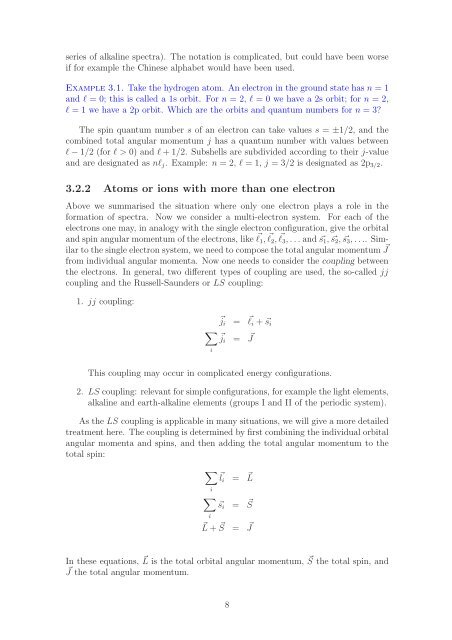Thermal X-ray radiation (PDF) - SRON
Thermal X-ray radiation (PDF) - SRON
Thermal X-ray radiation (PDF) - SRON
Create successful ePaper yourself
Turn your PDF publications into a flip-book with our unique Google optimized e-Paper software.
series of alkaline spectra). The notation is complicated, but could have been worse<br />
if for example the Chinese alphabet would have been used.<br />
Example 3.1. Take the hydrogen atom. An electron in the ground state has n = 1<br />
and l = 0; this is called a 1s orbit. For n = 2, l = 0 we have a 2s orbit; for n = 2,<br />
l = 1 we have a 2p orbit. Which are the orbits and quantum numbers for n = 3?<br />
The spin quantum number s of an electron can take values s = ±1/2, and the<br />
combined total angular momentum j has a quantum number with values between<br />
l − 1/2 (for l > 0) and l + 1/2. Subshells are subdivided according to their j-value<br />
and are designated as nl j . Example: n = 2, l = 1, j = 3/2 is designated as 2p 3/2 .<br />
3.2.2 Atoms or ions with more than one electron<br />
Above we summarised the situation where only one electron plays a role in the<br />
formation of spectra. Now we consider a multi-electron system. For each of the<br />
electrons one may, in analogy with the single electron configuration, give the orbital<br />
and spin angular momentum of the electrons, like ⃗ l 1 , ⃗ l 2 , ⃗ l 3 , . . . and ⃗s 1 , ⃗s 2 , ⃗s 3 , . . .. Similar<br />
to the single electron system, we need to compose the total angular momentum ⃗ J<br />
from individual angular momenta. Now one needs to consider the coupling between<br />
the electrons. In general, two different types of coupling are used, the so-called jj<br />
coupling and the Russell-Saunders or LS coupling:<br />
1. jj coupling:<br />
⃗j i = l ⃗ i + ⃗s i<br />
∑<br />
⃗j i = J ⃗<br />
This coupling may occur in complicated energy configurations.<br />
i<br />
2. LS coupling: relevant for simple configurations, for example the light elements,<br />
alkaline and earth-alkaline elements (groups I and II of the periodic system).<br />
As the LS coupling is applicable in many situations, we will give a more detailed<br />
treatment here. The coupling is determined by first combining the individual orbital<br />
angular momenta and spins, and then adding the total angular momentum to the<br />
total spin:<br />
∑<br />
i<br />
⃗ li<br />
∑<br />
⃗s i<br />
i<br />
⃗L + ⃗ S =<br />
= ⃗ L<br />
= ⃗ S<br />
⃗ J<br />
In these equations, ⃗ L is the total orbital angular momentum, ⃗ S the total spin, and<br />
⃗J the total angular momentum.<br />
8
















